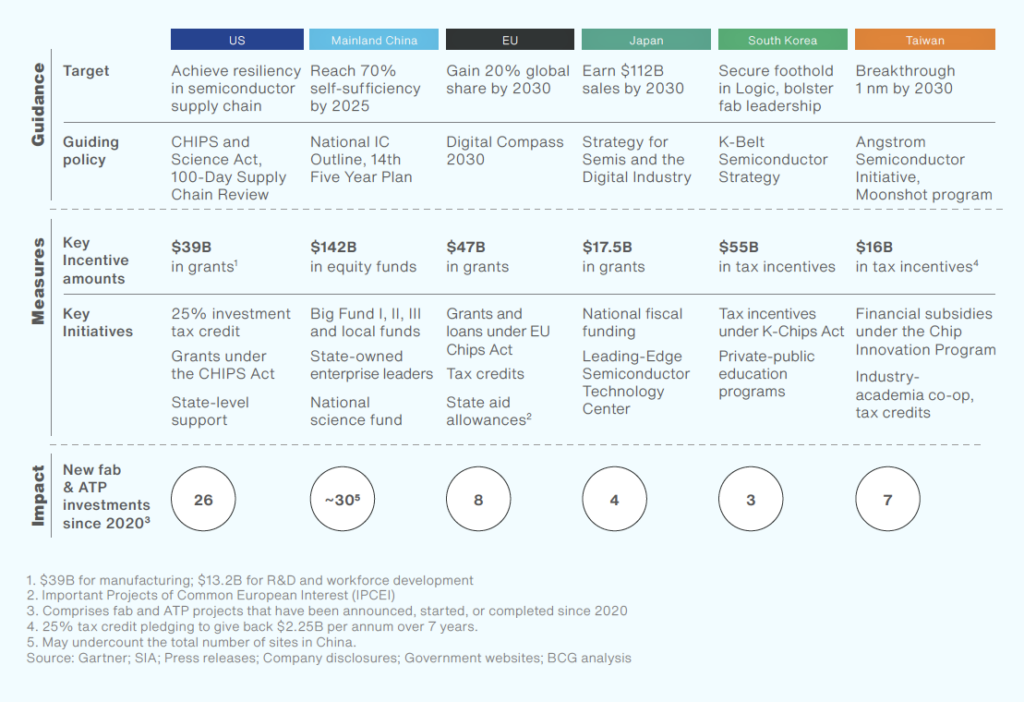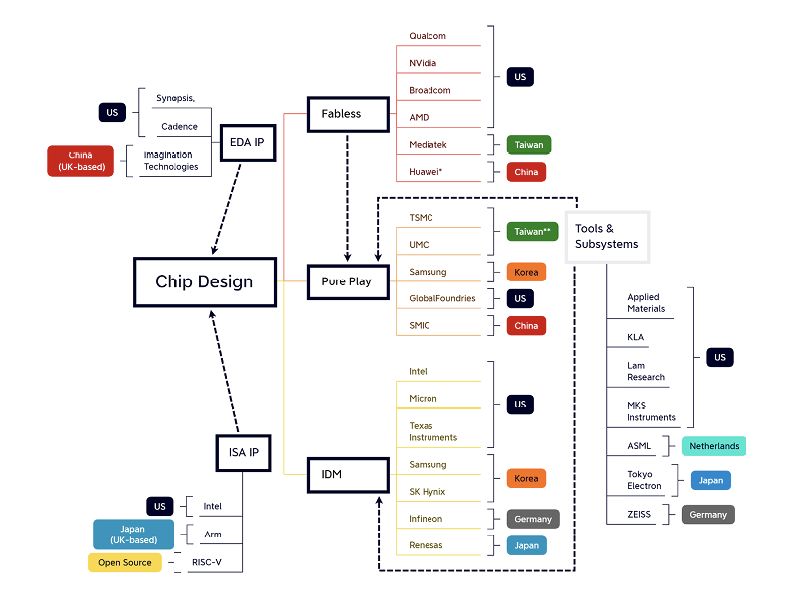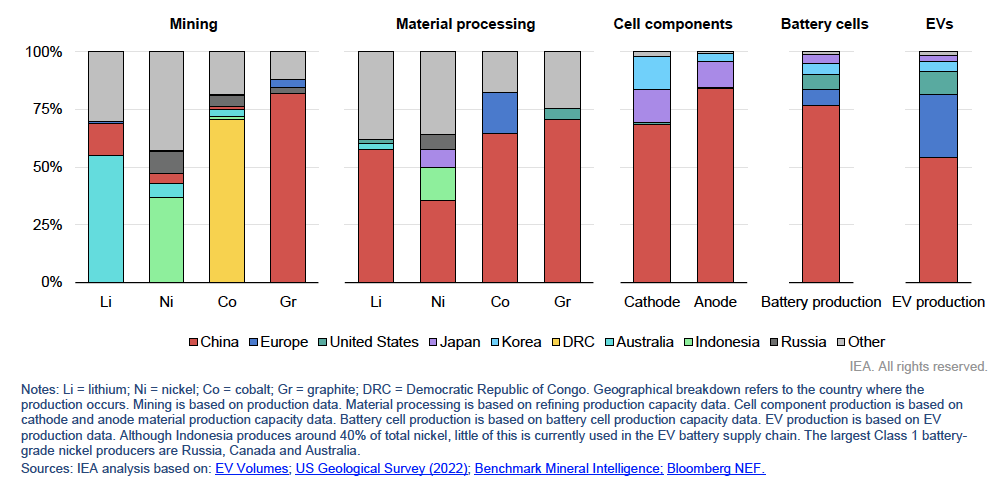On October 7, 2022, the US Department of Commerce’s Bureau of Industry and Security (BIS) released the implementing rules to support Joe Biden’s export controls policy against China. In continuity with Donald Trump’s “America First” Strategy, Biden imposed restrictions on the purchase, license acquisition, and exports to China of advanced computing chips, supercomputers, and high-powered semiconductors—all in the name of national security.1 A year later, the BIS further tightened the restrictions to ensure no advanced manufacturing equipment ends up in Chinese fabrication facilities. The impact was compounded through international partners like Japan and the Netherlands, who were prohibited from selling semiconductor manufacturing equipment like lithographic machines.
The US’s export controls policy is part of a wider strategy to regain control over the global semiconductor industry. With the CHIPS act of 2022, Biden signed $39 billion in grants and loans for semiconductor manufacturing into law. Emphasis has been on developing US leadership in semiconductor R&D, including a projected increase of 203 percent in wafer fab capacity by 2032 and marked improvement in critical technological frontiers such as leading edge fabrication, DRAM memory and analog chips, and advanced packaging.
This reverses the decades-long trend of globalization of chip-making, in which design and manufacturing were divorced from each other in an effort to promote efficiency, lowering costs of fabrication, and seeking more profits in a low return, high risk sector.2
In response, China has poured $1.7 billion in subsidies towards domestic chip companies in 2022 to achieve self-sufficiency, undertaken massive state-led investments through the National Integrated Circuit Industry Investment Fund, and announced a plan to build technological infrastructure critical bottlenecks like wafer fabrication and lithographic machines. China has also imposed retaliatory trade measures in 2023, such as a licensing system for critical raw materials like gallium and germanium needed for chip-making.
The slew of export restrictions between the US and China is an important sign of the raging high tech warfare that underpins the new logic of industrial policy in the post-neoliberal global order. Industrial strategy has been implemented in the name of an economic war in which only a few countries are able to compete.
But even in the face of these escalating tensions, our global economy remains the site of overwhelming interdependence. A brief look at supply chains within the semiconductor industry readily demonstrates that decoupling may not be as easy as policymakers make it appear.
Figure 1: Major Industrial Policy Initiatives on Semiconductor Industry, 2020–Present

China in the chip wars
Chris Miller’s book, Chips War, demonstrates that the US’s hegemonic victory in the Cold War depended on its technological prowess in the semiconductor industry. Semiconductors—chips as tiny as sub-10 nanometres—are ubiquitous inputs across our supply chain, ranging from washing machines and computers to advanced technologies in new clean energy and missile and defense systems. The quest for producing smaller chips at maximum efficiency created a highly decentralized supply chain, whereby US firms sought to reduce costs by separating chip design from wafer fabrication manufacturing and subsequently differentiating assembly and packaging.3 This process of decentralization enabled the US to outcompete the former USSR in the arms race and overcome Japan’s challenge to US economic hegemony.
Cost reduction in chip manufacturing coincided with rising costs in fabrication and in design, compelling firms to specialize in very niche tasks, some of which have become indispensable.4 For example, Taiwan’s TSMC built their competitive advantage in pure play foundry, which meant that chip design became completely divorced from fabrication. South Korea’s Samsung, by contrast, specialized in memory chips while chip design remained under the hands of American companies, thanks to the development of electronic design automation (EDA) tools.
The US’s control over global chip production poses a significant obstacle to Chinese development. China entered the supply chains of semiconductors amid stiff competition, with East Asian economies already well ahead in wafer fabrication capacity and the European Union (EU) and Japan on a race to regain their competitive edge in chip design and equipment manufacturing. Prior to US-China competition, Chinese companies took advantage of openings in the assembly and packaging, and then gradually transitioned into upstream segments (see Figure 1). Between 1978 and 1999, China focused its industrial policy on leveraging the large domestic market to encourage private investments in chip-making, encouraging joint ventures and acquiring assets to close the technological gap between China and the US, Europe, and Japan. China has therefore long viewed the semiconductors supply chain as pivotal for its progress in industrial development.
Figure 2: Leading Companies in the Semiconductors Chip Design and Manufacturing Segments of Supply Chain

Note: Huawei was a top chipmaker for three years until BIS put the company in the Entity List. Taiwanese firms TSMC & UMC are listed on the NASDAQ and have major American shareholders.
The US’ current containment strategy against China has been successful precisely because of the sheer structural power of American firms in the lucrative upstream segments of the supply chain. As long as China depends on American companies for EDA tools and IP design, any shift in US government policy aimed at curbing access to advanced Chinese chip-making tools is likely to slow down China’s rise in the hi-tech ladder.
Since 2018, China has sought to balance against this power by expanding its own manufacturing capabilities. In line with its self-sufficiency principle, in early 2023, the government designated five key firms— Huawei, SMIC, YTMC, and toolmakers Naura and AMEC—to gain privileged access to government R&D. As a result, Huawei made significant R&D headway in critical segments, such as deep ultraviolet and extreme ultraviolet lithography systems. This fabrication equipment is vital for Chinese lithography companies given their technological lag compared to industry leaders Dutch ASML and Japanese Nikon and Canon.
The reality of co-dependence
Despite rising tensions between the great powers, the reality remains one of significant co-dependence. As the 2023 US-China Economic and Security Review Commission opined, the United States is heavily reliant on Chinese production of key minerals, both for sourcing directly from China and indirectly through the predominance of Chinese gallium (53 percent share) and germanium (54 percent) in global supply chains (see Table 1). This, in turn, makes the Chinese export control policy imposed on critical minerals effective in ensuring the resilience of supply chains for advanced manufacturing. Without a diversified supply chain, quid pro quo bargaining between the US and China and more measured restrictions are likely to continue in order to ensure that global supply chains are not entirely disrupted.
Table 1: Critical Minerals the United States Primarily Sourced from China, 2022
| Critical Mineral | China’s Share of US Imports | Major Uses |
| Antimony | 63% | Flame retardant; antimonial lead and ammunition |
| Arsenic | 57% | Herbicide and insecticide; wood pressure treatment; semiconductors for solar cells, space research and telecommunications |
| Barite | 38% | Oil and natural gas drilling; radiation shields at nuclear plants and for x-ray |
| Bismuth | 65% | Metal additive for cast iron and pope fittings; pharmaceuticals; semiconductor manufacturing |
| Gallium | 53% | Manufacturing of semiconductor wafers |
| Germanium | 54% | Semiconductor manufacturing; solar cells; fiberoptics; LED |
| Graphite | 33% | Batteries; brake linings; lubricants; steel-making |
| Rare earths elements (compounds and metals) | 74% | Magnets; catalysts; metallurgical; battery alloys |
| Tantalum | 24% | Alloys for gas turbines used in aerospace and oil and gas industries; automotive and consumer electronics |
| Tungsten | 29% | Cutting and wear-resistant applications in construction, metal-work, mining, and oil and gas drilling; specialty steel alloys; electrical components |
| Yttrium | 94% | Catalysts, electronics, lasers, metallurgy; jet engine coatings, sensors, bearings, and seals |
A second point is more obvious: China remains a huge market for intermediate and end-user products. Chinese consumer power remains an important aspect for any long-term business strategy for Western firms. Dutch and Japanese companies’ resistance to their governments’ respective exports control policies demonstrates the power of the Chinese market. Access to this consumer base is equally important for firms as geopolitical objectives are to their national governments.
In the highly lucrative battery supply chain, which links the critical minerals sector to electric vehicles, China has secured its position as a major producer (see Figure 3). China’s industrial policy built economic linkages between mining and the productive economy. This reflects the manufacturing prowess of China and the likely future of industrial competition between China and the West.
Figure 3: China and the Global Supply Chain Linking Critical Raw Materials and EV Cars

We are unlikely to return to the pre-COVID economy, in which American capital alone shapes the fate of global economic growth and prosperity. Regardless of who wins in the US presidential election in November, the cross-party consensus demonstrates strong preferences towards containing China’s economic ambitions, and with it, military expansion. Yet, despite the turbulence in US-China relations, the goal of decoupling is unlikely to happen soon. Instead, achieving supply chain resilience necessitates seeking new ways of cooperation in the face of proliferating barriers.
FootnotesGenerally, when a party is added to the Entity List, anyone seeking to export, reexport, or transfer items under Commerce jurisdiction to a listed party must first seek a license to do so from Commerce. As with other license applications, those applications are reviewed by the Departments of Commerce, State, Defense, and Energy. License applications for most entities on the Entity List are subject to a presumption of denial, regardless of the sensitivity of the item to be exported.
Brown, Clair, and Greg Linden. 2011. Chips and Change : How Crisis Reshapes the Semiconductor Industry. Cambridge, Mass.: MIT Press.
Semiconductor manufacturing is called fabrication in factories called fabs, which in turn require highly specialized and very costly equipment.
Brown and Linden.
Filed Under

